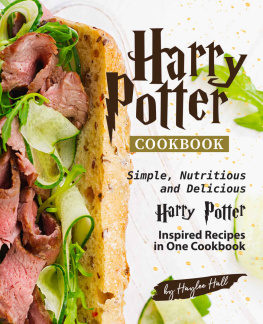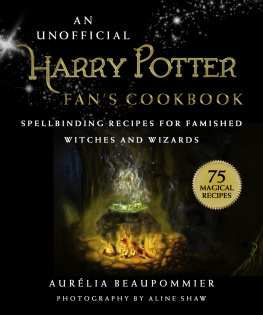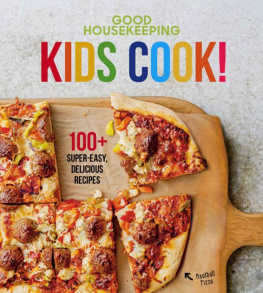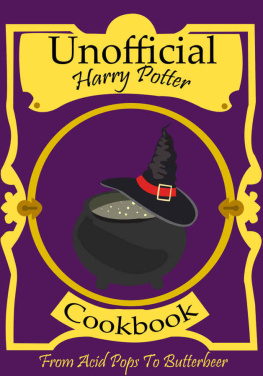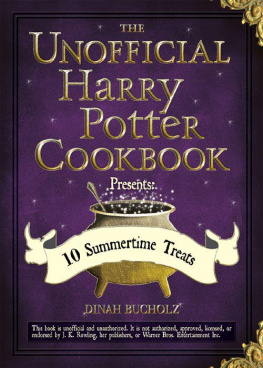This book is not associated with or authorized or approved by J. K. Rowling, her publishers, or Warner Bros.
Introduction
Welcome, young witches, wizards, and non-magical folk alike! In the following pages youll find magical, fantastical recipes inspired by what students might eat in the Great Hall at Hogwarts, plus some other meal ideas that witches and wizards in training might eat at other magic schools around the world. After all, theres only so much meat pie a kid can handle! Its important to fill your stomach with a variety of food groups while youre filling your mind with spells, potions, and facts about magical plants and creatures.
This book will provide some old British classics as well as some newer American favorites. Youll find the recipes organized by meal type, ranging from yummy breakfasts all the way to delicious drinks. If you are just starting out in the kitchen, you can begin with some of the recipes in the Snacks and Small Treats section, as well as in the Drinks section, and make sure to read through the helpful advice for beginner cooks.
Some of the more traditional dishes can get pretty fussy, so Ive pared down the steps and ingredients to make the final product easier to achieve (especially if you dont have the help of a wand or self-stirring cauldron). That being said, the dishes youll make with the help of this cookbook will certainly taste as magical as the ones from your favorite book series. Tuck in!
In the Home Kitchen How to Cook without a Magic Wand
Advice for BeginnersSafety
Though this isnt potions class taught by an extremely strict professor, its still very important to follow the kitchen rules. After all, you want to keep your eyebrows intact and avoid explosions or melting cauldrons. Take a look at the following safety advice before heading into the kitchen to brew up a potion or bake a magical treat.
- Ask an adult before beginning: Talk about what recipe youre planning to make; they might have some advice for you. Let them look over the ingredients and tools youll need to make sure youre set up for success.
- When in doubt, wash your hands: Wash your hands before cooking, after handling raw meat, after cutting smelly ingredients like garlic, and after picking up something you dropped on the floor. Wash those hands!
- Roll up your sleeves and pull back your hair: Sleeves can get in the way and knock things over while youre cooking. They can also catch on fire if youre working over the stove. Be sure to roll your sleeves up so none of that happens.
- Clean up after yourself: Cooking can get messy, and thats okay! But its important to clean up the mess after youve made it. Since you probably havent mastered a room-cleaning charm yet, youre going to have to tidy up the old-fashioned way. You can even try cleaning as you cook so it isnt as big of a task at the end.
- Ask for help before using a utensil for the first time. Like I said before, you want to keep your eyebrows intact. Instead of barreling ahead, pause and make sure youre doing things correctly. Just as its important to pronounce spells correctly, its important to use tools in the correct manner.
- Pay attention to hot surfaces. Keep towels (both paper and cloth), oven mitts, and potholders away from the stove.
- Do your homework! Review the recipe directions and ingredient list before you begin to cook.
- Prep all ingredients. Take the time to gather and prepare your ingredients before you begin.
- Practice knife safety: Think SASS.
- StopPause and make sure no one is within arms reach
- AwayCut away from your body and fingers
- SharpA dull knife is dangerous! A sharp, clean knife is a safe knife.
- StoreWhen youre done with the knife, make sure to put it away in a sheath or knife block.
- Another thing to keep in mind is to always cut on a cutting board. Your parents wont be pleased if their countertops suddenly look like theyve taken a beating by an enchanted and particularly violent willow tree.
- Wear closed-toe shoes. If you are just learning how to handle a knife it might be a good idea to wear closed-toe shoes in case the knife accidentally falls.
- Turn off the stove. If youre in the middle of cooking and you need to leave the kitchen for some reason, turn off the stove. You can turn it on again when you get back.

Common Recipe Terms
Al dente: Cooked until firmnot crunchy and not too soft.
Bake: To cook food in an oven using dry heat.
Baste: To add moisture to food while youre cooking it so it doesnt dry out.
Beat: To stir very fast until a mixture becomes smooth. You can do this with a spoon, whisk, or mixer.
Blanch: To boil fruit or veggies for a short amount of time to seal in color and flavor.
Boil: To cook in water that has reached 212F.
Braise: To brown first, then simmer food over low heat in a small amount of liquid. The pan should be covered. This results in tender meat.
Broil: To cook on a rack under direct heat. You can do this in an oven.
Brown: To cook on high heat to add darker color to the food.
Caramelize: To heat sugar until it melts and turns into a syrup. The syrup can look golden, brown, or even dark brown.
Chop: To cut food into small pieces (think: the thickness of a pencil). If your recipe says finely chopped, cut pieces to half the thickness of a pencil.
Cream: To beat ingredients together until smooth.
Cube: To cut food into pieces that are around -inch wide.
Dash: teaspoon.
Dice: To cut food into very small pieces, around -inch wide. Sometimes dice and chop are used interchangeably, but in general, dice means smaller pieces than chop.
Dredge: To coat uncooked food in breadcrumbs, flour, or some other mixture.
Dust: To lightly cover a dessert with powdered sugar or to dust a surface or dough with flour before rolling.
Fold: To gently use a spatula to mix light ingredients (like beaten egg whites) into heavy ingredients. The point of folding is to try to keep as much air in the mixture as possible.
Glaze: To coat food in sauce, icing, or other glossy liquids.
Grate: To rub food against a serrated tool, resulting in shredded bits.
Knead: To mix dough together using your hands or a mixer.
Mince: To cut ingredients into teeny tiny pieces.
Pinch: 116 teaspoon.
Poach: To cook over low heat, with liquid just barely simmering.


